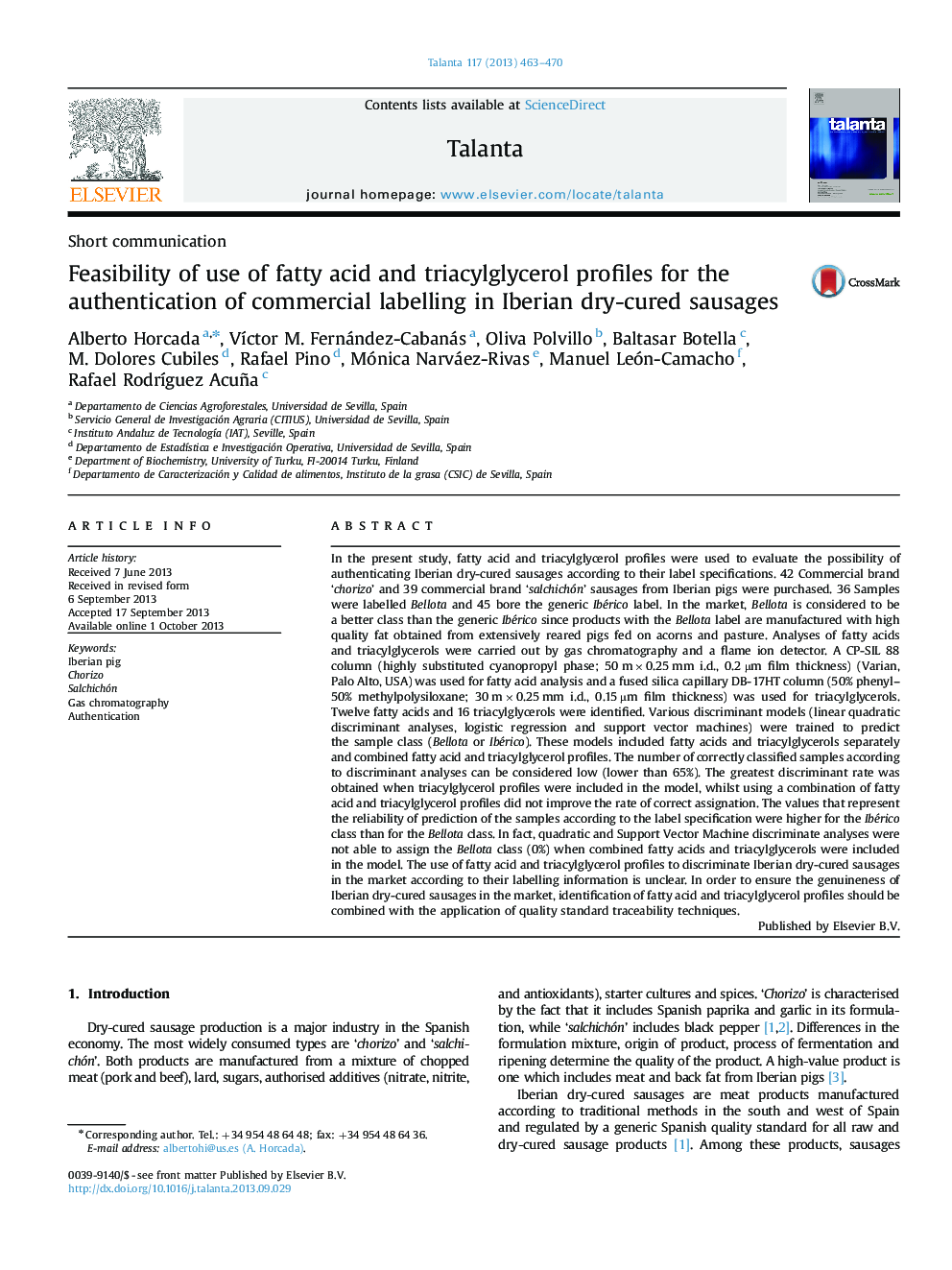| کد مقاله | کد نشریه | سال انتشار | مقاله انگلیسی | نسخه تمام متن |
|---|---|---|---|---|
| 7682422 | 1495818 | 2013 | 8 صفحه PDF | دانلود رایگان |
عنوان انگلیسی مقاله ISI
Feasibility of use of fatty acid and triacylglycerol profiles for the authentication of commercial labelling in Iberian dry-cured sausages
ترجمه فارسی عنوان
امکان استفاده از پروفیل های اسید چرب و تریاسیل گلیسرول برای تأیید اعتبار تجاری در سوسیس خشک شده ایبرین
دانلود مقاله + سفارش ترجمه
دانلود مقاله ISI انگلیسی
رایگان برای ایرانیان
کلمات کلیدی
خوک ایبرین، چوریزو، سالچیکون، کروماتوگرافی گازی، احراز هویت،
موضوعات مرتبط
مهندسی و علوم پایه
شیمی
شیمی آنالیزی یا شیمی تجزیه
چکیده انگلیسی
In the present study, fatty acid and triacylglycerol profiles were used to evaluate the possibility of authenticating Iberian dry-cured sausages according to their label specifications. 42 Commercial brand 'chorizo' and 39 commercial brand 'salchichón' sausages from Iberian pigs were purchased. 36 Samples were labelled Bellota and 45 bore the generic Ibérico label. In the market, Bellota is considered to be a better class than the generic Ibérico since products with the Bellota label are manufactured with high quality fat obtained from extensively reared pigs fed on acorns and pasture. Analyses of fatty acids and triacylglycerols were carried out by gas chromatography and a flame ion detector. A CP-SIL 88 column (highly substituted cyanopropyl phase; 50 mÃ0.25 mm i.d., 0.2 µm film thickness) (Varian, Palo Alto, USA) was used for fatty acid analysis and a fused silica capillary DB-17HT column (50% phenyl-50% methylpolysiloxane; 30 mÃ0.25 mm i.d., 0.15 µm film thickness) was used for triacylglycerols. Twelve fatty acids and 16 triacylglycerols were identified. Various discriminant models (linear quadratic discriminant analyses, logistic regression and support vector machines) were trained to predict the sample class (Bellota or Ibérico). These models included fatty acids and triacylglycerols separately and combined fatty acid and triacylglycerol profiles. The number of correctly classified samples according to discriminant analyses can be considered low (lower than 65%). The greatest discriminant rate was obtained when triacylglycerol profiles were included in the model, whilst using a combination of fatty acid and triacylglycerol profiles did not improve the rate of correct assignation. The values that represent the reliability of prediction of the samples according to the label specification were higher for the Ibérico class than for the Bellota class. In fact, quadratic and Support Vector Machine discriminate analyses were not able to assign the Bellota class (0%) when combined fatty acids and triacylglycerols were included in the model. The use of fatty acid and triacylglycerol profiles to discriminate Iberian dry-cured sausages in the market according to their labelling information is unclear. In order to ensure the genuineness of Iberian dry-cured sausages in the market, identification of fatty acid and triacylglycerol profiles should be combined with the application of quality standard traceability techniques.
ناشر
Database: Elsevier - ScienceDirect (ساینس دایرکت)
Journal: Talanta - Volume 117, 15 December 2013, Pages 463-470
Journal: Talanta - Volume 117, 15 December 2013, Pages 463-470
نویسندگان
Alberto Horcada, VÃctor M. Fernández-Cabanás, Oliva Polvillo, Baltasar Botella, M. Dolores Cubiles, Rafael Pino, Mónica Narváez-Rivas, Manuel León-Camacho, Rafael RodrÃguez Acuña,
